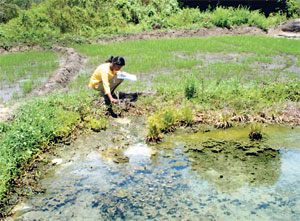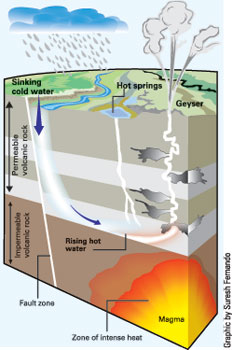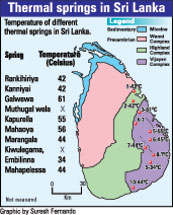With the ever-growing demand for power and energy requirements in Sri Lanka, the country is increasingly becoming dependent on foreign energy sources, importing natural gas and petroleum products mainly from oil-producing countries.
The country’s potential for hydro-electric power generation has already been largely exploited, but what of the hidden geothermal energy in the subsurface in the areas of the 10 hot-water springs which so far have only been used for bathing due to their medicinal and healing properties including the therapeutic power for skin conditions and rheumatic arthritis? Medicinal bathing is popular at the Mahapelessa spring.
 |
| Thermal springs at Marangala Wahawa. (Temperature 440C) |
These hot water or thermal springs along a narrow belt running from Hambantota to Trincomalee occur within the boundary of two main geological units -- Highland and Vijayan complexes. These springs are surface manifestations of subsurface hidden heat (energy) sources such as huge bodies of ‘hot dry rocks’, ‘deeply extending fracture zones’ or concealed magma chambers’.
However, since Sri Lanka is not in an active volcanic or tectonic region of the earth crust, magma chambers can be ruled out.
The temperatures of the thermal springs range from 350 to 610 Celsius and only limited preliminary scientific studies have been carried out so far, while no detailed geological studies, geophysical exploration and test-drilling have been conducted.
What is geothermal
energy?
There is a tremendous amount of heat energy trapped inside the earth from the decay of radioactive elements, in magma and dry hot rocks, sometimes as shallow as a km or two below the surface. The earth's interior can be compared to a natural nuclear power reactor. Usually, the earth's natural heat increases around 30º C with every km of depth, with this heat flow being an indication of the tremendous amounts of heat energy at the earth's interior. Sometimes, this heat erupts from the earth’s surface in the form of lava, steam or hot water. This is geothermal energy.
Water from rain and snow seeps into the ground through the soil and then percolates through permeable rocks and geological structures. This water accumulates in geological formations which are known as aquifers. Aquifers while storing water also permit it to flow through. If the aquifer is deep enough, it may rest on the impermeable rock layer that is in contact with magma or dry hot rock and thus water in such an aquifer will be very hot, soaking up heat and circulating through its structural components.
Dry hot rock -- naturally heated, unmelted crystalline rocks which lie beneath the surface in areas where the geothermal gradient is two or three times greater than normal -- is also a source of geothermal energy. If the heated water encounters some fracture leading upward, it expands, becomes less dense and rises to the surface as hot water or steam forming thermal springs or geysers. Geysers are the thermal springs which splash boiling water and steam.
The rising water is replaced with denser cold water seeping into the aquifer. Hot-water bodies do not always announce their exact location in the form of hot springs or geysers. They are often hidden in some areas of subsurface dry hot rocks. Thus, knowing the geology and the structure of the geothermal fields will facilitate the delineation of favourable prospects.
Electricity generation
Electricity is the most profitable use of geothermal energy. To generate electricity, fluids above 1500C are extracted from underground porous or fractured rocks at depths between a few hundred to three kilometres and brought to the surface through tube wells. As soon as the pressure is released, some of this fluid flashes into steam that rushes off to turn a turbine that spins a generator. The spent steam is then chilled in a condenser and changed to water to be pumped back into the ground. The size of the steam plant unit ranges from 0.1 to about 150 MW .
 |
If the geothermal resource has a temperature between 1000 and 1500C, electricity can still be generated using binary plant technology, using a heat exchange method. Here, heat from the geothermal fluid is transferred to another liquid, that vapourizes at low temperature and turns into a highly-pressurized gas that turns the turbine. The vapourized liquid is then recycled back into the system. The size of binary units range from 0.1 to 40 MW.
Current studies conducted at the thermal springs in Sri Lanka have revealed that the source temperatures at sub-surface are between 1350 and 2000 Celsius.
Environmental impacts
From the environmental perspectives, geothermal energy is also clean, producing only a small percentage or none of the air pollutants emitted by burning fossil fuels. Geothermal power plants emit little carbon dioxide (fossil-fuel power plants produce 1000 to 2000 times as much), no nitrogen oxides, no particulate matter and low amounts of sulfur dioxide. Steam and flash plants emit mostly water vapour. Binary power plants run on a closed-loop system, so no gases are emitted.
Development of a
national strategy
Prospects of low to medium temperature geothermal resources can be spread over the thermal-springs belt in Sri Lanka. There is also potential for direct-use applications in the food processing, fruit drying, refrigeration, fish hatchery and farming, recreation and tourism spheres.
Geothermal energy is not dependent on the weather unlike solar, wind or hydro power. Therefore, potential geothermal energy reserves in the country could probably provide (if not fully) at least part of the electricity requirements.
However, to develop the potential geothermal prospects for industrial exploitation, systematic geological, geochemical and geophysical techniques are required to locate and delineate shallow producing geothermal fields. Such work will pinpoint with accuracy the particular depths of hot-water reservoirs for drilling exploratory investigation boreholes.
A major exploration effort is needed to characterize geothermal reservoirs and prepare an inventory of potential geothermal areas for further development.
As this is one of the most environmentally clean and friendly sustainable renewable energy sources, Sri Lanka may also be able to get financing under the Clean Development Mechanism (CDM) promoted by the Kyoto Protocol, which encourages developed countries to invest in renewable energy projects in developing countries. The greenhouse gas credits created by geothermal power plants could be sold on global markets to bring extra cash revenues.
Sri Lanka, therefore, should make a strong commitment to develop these geothermal resources.
(The writer is Senior Lecturer in Hydrogeology & Applied Geophysics,
Department of Geology, University of Peradeniya) |



